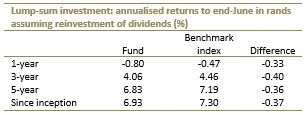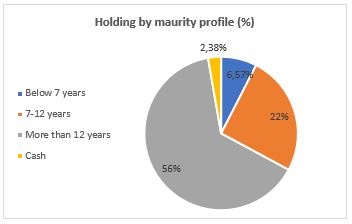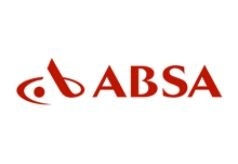Intellidex Reviews: NewFunds ILBI (inflation-linked bond index) ETF review
Protecting your money against inflation is crucial. An extreme example comes from Zimbabweans who retired between 2000 and 2009, and had their life savings decimated. The inflation rate eclipsed 76-billion percent in November 2008. To put this into perspective, if you had enough money in the bank to buy a townhouse in January 2008, by end of that year it would not have been enough to buy a loaf of bread. Zimbabwe is an extreme basket-case but it illustrates the importance of protecting your investment against inflation, particularly in a country where there is limited political will to implement market-friendly policies.
The UK government issued the first inflation-protected bonds in 1981 and they have since become widespread, with the SA government issuing its first batch in March 2000. In their simplest form, SA inflation-linked bonds adjust both the principal and coupon rate to the level of the South African Consumer Price Index. The underlying premise is that you should be able to maintain your buying power no matter what happens to prices.
Bonds have a different risk-return profile to equities, so they provide good diversification. The NewFunds ILBI ETF is designed to protect your investment against inflation. It provides exposure to SA’s investment-grade government bonds. Absa, the issuer, ensures that there is liquidity in the ETF so it is easy to buy and sell, unlike holding actual government bonds.
What it does
The NewFunds ILBI ETF tracks the performance of the Barclays/Absa South African government inflation-linked bond index (ILBI). The ILBI is a weighted basket of South African government inflation-linked bonds. The ETF tracks the component bonds of the index in proportion to the index weightings. It is restricted to certain government bonds, excluding corporate bonds and other issues by state-owned enterprises such as Eskom and Sanral.
Performance review
The NewFunds ILBI ETF poorly in the 12 months to end-June, losing 0.8%.

Outlook
Although Inflation-linked bonds are generally grouped together with nominal or vanilla bonds, they can exhibit very different payoffs. This is because their values are driven by different variables: whereas inflation-linked bonds derive their value primarily from the inflation level, vanilla bonds derive the bulk of their value from changes in interest rates. When a vanilla bond and an inflation-linked bond are issued at the same time, they may start off similarly but the relationship changes with time. If inflation increases, the inflation-linked bond gains, but if inflation falls it will be more beneficial to hold the nominal bond.
Several other factors that affect the value of bonds including the credit profile of the issuer, liquidity, maturity profile, inflation level and interest rates (real interest rates in the case of inflation-linked bonds). The real interest rate is the rate of interest an investor receives after allowing for inflation. Government-issued inflation-linked bonds have a low credit risk profile so it is mainly the inflation level and real interest rates that affect returns.
The credit profile of our government has deteriorated markedly since the end of 2015. SA’s hard currency sovereign credit rating was downgraded to junk by two international rating agencies in the first half of the year and the political environment remains uncertain. That said, the main attraction of bonds is their ability to reduce risk in a portfolio of stocks, as they have different payoff profiles.
SA’s main inflation drivers include the oil price, weather conditions and rand movements. The first two factors have been positive recently, while the outlook for inflation and interest rates, for the short term, is benign. The Reserve Bank cut interest rates last month because inflation had not grown as feared.
Key facts
Suitability
This ETF is suitable for most investors wanting to protect their buying power. It can be used as a building block for your core portfolio or can be applied tactically in a core-satellite strategy, depending on your views on inflation. If you think inflation is going to be high in the short term you can increase your exposure, and sell when you think inflation is going to ease.

Top holdings
The fund is invested in bonds issued by the SA government with more than half of the bonds having maturities of 12 years or more.
Risks
The most common risks associated with inflation-linked fixed-income securities are credit risk and interest rate changes. Fortunately, all the constituents of this fund are sovereign bonds issued by the SA government, which means credit risk is minimal. Real interest rate risk arises from fluctuating real interest rates. As real interest rates rise, bond prices fall and vice versa.

Alternatives
NewFunds IFBI ETF is one of four ETFs listed on the JSE that provide investors with low-cost exposure to fixed-income securities. Retail investors seeking exposure to fixed income assets have three other options: Ashburton Government Inflation ETF (TER : 0.47%); NewFunds Govi ETF (TER: 0.26%); and Satrix ILBI (expected TER: 0.25%).
Background: Exchange-traded funds (ETFs)
Exchange-traded funds (ETFs) are passively managed investment funds that track the performance of a basket of pre-determined assets. They are traded the same way as shares and the main difference is that whereas one share gives exposure to one company, an ETF gives exposure to numerous companies in a single transaction. ETFs can be traded through your broker in the same way as shares, say, on the EasyEquities platform. In addition, they qualify for the tax-free savings account, where both capital and income gains accumulate tax free.
Benefits of ETFs
- Gain instant exposure to various underlying shares or bonds in one transaction
- They diversify risk because a single ETF holds various shares
- They are cost-effective
- They are liquid – it is usually easy to find a buyer or seller and they trade just like shares
- High transparency through daily published index constituents
If you thought this blog was interesting, you should also read:
Intellidex reviews:
NewFunds Govi ETF
Disclaimer
This research report was issued by Intellidex (Pty) Ltd. Intellidex aims to deliver impartial and objective assessments of securities, companies or other subjects. This document is issued for information purposes only and is not an offer to purchase or sell investments or related financial instruments. Individuals should undertake their own analysis and/or seek professional advice based on their specific needs before purchasing or selling investments. The information contained in this report is based on sources that Intellidex believes to be reliable, but Intellidex makes no representations or warranties regarding the completeness, accuracy or reliability of any information, facts, estimates, forecasts or opinions contained in this document. The information, opinions, estimates, assumptions, target prices and forecasts could change at any time without prior notice. Intellidex is under no obligation to inform any recipient of this document of any such changes. Intellidex, its directors, officers, staff, agents or associates shall have no liability for any loss or damage of any nature arising from the use of this document.
Remuneration
The opinions or recommendations contained in this report represent the true views of the analyst(s) responsible for preparing the report. The analyst’s remuneration is not affected by the opinions or recommendations contained in this report, although his/her remuneration may be affected by the overall quality of their research, feedback from clients and the financial performance of Intellidex (Pty) Ltd.
Intellidex staff may hold positions in financial instruments or derivatives thereof which are discussed in this document. Trades by staff are subject to Intellidex’s code of conduct which can be obtained by emailing mail@intellidex.coza.
Intellidex may also have, or be seeking to have, a consulting or other professional relationship with the companies mentioned in this report.
Subscribe To Our Research Portal
Search all research
Let Us Help You, Help Yourself
From how-to’s to whos-whos you’ll find a bunch of interesting and helpful stuff in our collection of videos. Our knowledge base is jam packed with answers to all the questions you can think of.

